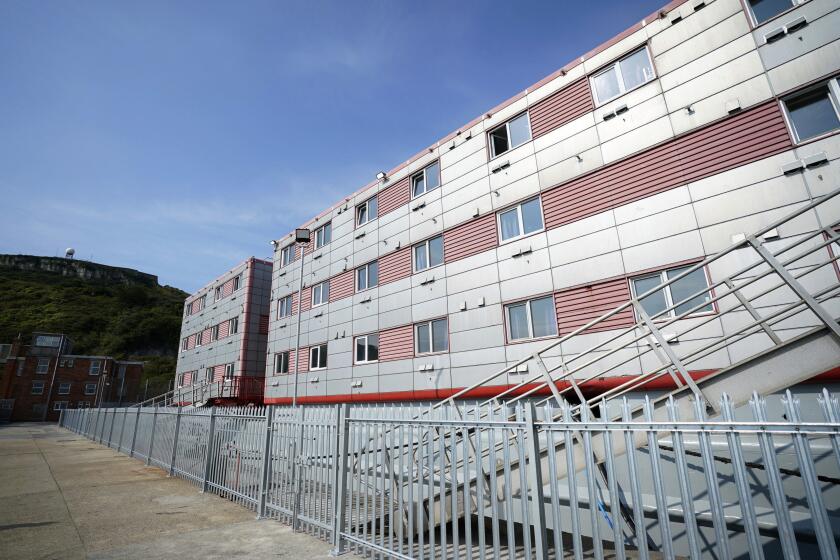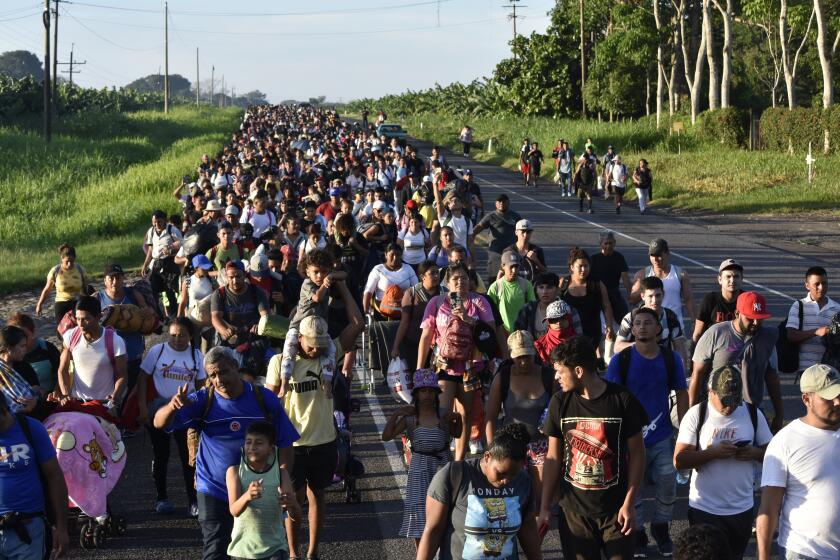Plan for Alien Jail on Reservation Meets Opposition
Like other American Indian communities nationwide, the impoverished Viejas band of Mission Indians has considerable land but is in dire need of jobs and development.
At the same time, the U.S. Immigration and Naturalization Service has lots of jobs and a large budget but needs more jail space to house some of the hundreds of thousands of illegal aliens it arrests every year in Southern California.
A singular convergence of these two contrasting needs is unfolding in a scenic backcountry valley, home of the Viejas Indian Reservation in San Diego County.
The INS has awarded a contract to a private corporation, Esmor Inc., to build and operate a jail on reservation property to house the undocumented immigrants. Most of those to be held at the 240-bed jail would be undocumented Central Americans, many of them partial or full-blooded Indians--a fact that has stirred debate about whether such a jail is an appropriate use of reservation territory.
“It’s kind of ironic to put a prison facility on an Indian reservation in America to house people from Mexico and Central America who are also Indian,” said Barbara Muller, a 36-year-old mother of two who lives on the reservation and is opposed to the plan. “I just don’t like the image of the INS being on an Indian reservation.”
The Viejas tribal council has approved the plan; all that’s needed is final approval by the U.S. Bureau of Indian Affairs. The facility, costing as much as $5 million, could be under construction within a month and occupied by late fall, said an official of Esmor, one of a number of private jail providers that have sprung up nationally in recent years as federal and local law enforcement agencies look for less-costly alternatives to public jails.
The plan to build the jail on the reservation, home to about 250 people, is one of the vast array of potentially revenue-enhancing proposals considered by the nation’s Indian communities, where unemployment and despair are chronic. Some leaders have attempted to entice virtually any kind of development to the reservations, from mines to ski lodges to factories to farms.
“Most of the tribes are looking for anything that will bring income,” noted Suzan Harjo, executive director of the Washington-based National Congress of American Indians, the best-known Indian-rights organization.
Bingo gambling, which Viejas has long sought, has become well-established at other reservations throughout the country. And two years ago, backcountry San Diego residents were relieved when the Campo band of Mission Indians scrapped a plan to house a plant to drain cancer-causing polychlorinated biphenyls (PCBs) from old transformers.
New Plan Spreading
The planned jail at Viejas is one of a number being contemplated throughout the region, reflecting the philosophy of the Ronald Reagan and Bush administrations that incarceration is an effective deterrent to illegal immigration. Many critics disagree with the policy, particularly when it comes to Central Americans, who are often fleeing political turmoil and warfare, as well as economic underdevelopment.
Though Mexican nationals represent the great majority of undocumented immigrants arrested, most are quickly returned to Mexico, obviating the need for detention space. But many Central Americans file a formal request for political amnesty, which precludes deportation until the request is resolved.
Such broad policy questions seem far from the debate at Viejas, a sleepy, insular community spread over 1,600 rolling acres of chaparral and pasture. Tribal leaders have applauded the plan to build the jail on a 10-acre piece of land as a necessary step for economic development. The proposal was approved by 75% of the band’s enrolled members who were at a public session, tribal documents state, but it is unclear how many of the 100 or so voting members were there for the vote.
The band would receive $10,000 a month for the life of the 25-year lease with Esmor; the first 18 months of rent would be provided up front to purchase an additional 90 acres of land near the northwestern part of the reservation.
Despite the monetary rewards, objections persist.
The reservation sits just 20 miles north of the U.S.-Mexico border and is frequently traversed by undocumented border-crossers heading north. Older band members recall crossing the border casually to shop, before the time of widespread formal inspections. Today, dark-skinned residents say they are occasionally stopped by U.S. Border Patrol officers and asked whether they are citizens.
Relatives Across Border
Muller, the mother of two, notes that just 30 miles south of the reservation--in Mexico--there are Indians related to the Viejas band. Such people, she said, could theoretically end up in custody on Viejas property as undocumented immigrants.
Many tribal members wary of the jail plan note that the benefits of Viejas’ largest commercial development, a long-established campground, have yet to filter down to residents. In the 41-page proposed lease for the jail property, Esmor has vowed to attempt to hire Viejas members or other Indians during jail construction and the subsequent operation “to the greatest extent feasible.” But no jobs among the 50 to 60 full-time positions are guaranteed to the Indians. (A handful of INS personnel will also be on site.)
To some, the potential rewards seem slight compared to the likely upset--the comings and goings of Border Patrol vans and workers’ vehicles, the glaring lights, the noise, the fences, the possible escapes from the quiet valley that abuts Interstate 8 near rural Alpine.
“A jail’s not going to help anybody,” said Dianna Vigil, a 32-year-old mother of five whose home is near the proposed site. “There’ll be a lot of patrolling, a lot of fences going up, a lot of lights. We won’t be able to let our kids out like we do now.”
Public Hearings
Some said there had not been proper public notice about the plan, though the tribal council has held at least two public hearings on the matter--one last July and one in December.
Mabel Velasquez, an enrolled tribal member who attended the session at which the matter was voted on, said she recalled that fewer than one-third of the 100 or so voting band members attended that critical session.
“They should have been going door to door, telling people what was going on,” said Velasquez, who said she voted against the plan, fearing it would upset the reservation’s quiet pace. “You just have to be here in this environment to appreciate the quality and the blackness. I can imagine them lighting up our skies.”
Anthony Pico, the tribal chairman, said neither he nor other tribal council members can comment on the matter. He cited a policy not to make public statements on development projects. Records of the council meetings are not available to the general public.
The jail proposal is the culmination of several years of discussions between INS officials and several San Diego-area Indian bands over possible sites for jails. The Barona band of Mission Indians, near the Viejas band, considered such a plan in 1986-87 but scrapped the idea after intense opposition.
Year-Old Plan
The current proposal was born about a year ago, when Esmor representatives contacted Viejas officials, according to Richard P. Staley, Esmor’s vice president. In December, the INS awarded Esmor the contract to construct and manage the facility, said Christine Davis, assistant regional INS commissioner for detention and deportation in Los Angeles.
Esmor is a firm barely more than a year old--formed specifically to participate in the fast-growing commercial jail business, according to Staley, a 30-year INS veteran and one of a number of former INS officials affiliated with Esmor. The company also has an INS contract in Seattle and plans to operate a facility for the U.S. Bureau of Prisons in New York, Staley said.
As for safety concerns at the minimum-security facility, Staley said that no dangerous “criminal aliens”--those convicted of serious non-immigration crimes--would be housed there. “It’s not correct to say it’s a day-room environment, but you know what I’m talking about,” Staley said. “It’s a clean type of industry.”
However, Davis, the INS official in charge of deportation matters, said she could not rule out the possibility that some criminal aliens might be temporarily housed on the reservation, though the facility is not intended for them. Men, women and children would be housed at the concrete jail, which would consist of 16-bed dormitories and two interior courtyards to be used for recreation.
More to Read
Sign up for Essential California
The most important California stories and recommendations in your inbox every morning.
You may occasionally receive promotional content from the Los Angeles Times.





